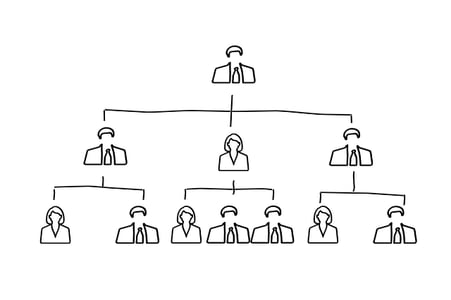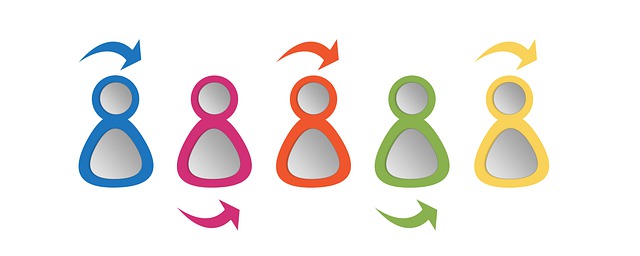Successful businesses have something in common. Their teams are structured in a way that encourages productivity, collaboration, efficiency, and cooperation. This structure must occur within each team and in each team’s relationship with other business areas.
So how should you structure your teams? That’s not an easy question to answer. This isn’t an exact science. If you randomly selected some of the top companies in the world and examined their team structures, you would see some pretty extreme variances, including:
- Flat vs. deep hierarchies
- Loosely vs. clearly defined roles
- Formal chains of command vs. consensus building
- Centralized vs. distributed team structures
Even within the same organization, teams may need to be structured differently to be successful and achieve organizational goals.
 Google is renowned for having a flat org structure.
Google is renowned for having a flat org structure.
The Difference Between Team and Org Structures
Most organizations will have two distinctly separate sets of structures that influence how roles, responsibilities, authorities, and workflow are handled. These are team and org structures. It’s important to understand both and learn how one impacts the other.
Org Structures
It helps to think of org structure as a higher-level concept. This is the structure of the organization as a whole and the teams within it. Org structure defines how information, work, and responsibilities flow through an organization.
If a company has multiple teams that are defined by location, business function, or both, then org structure refers to how each of those teams interacts with the others.
There are various ways that companies can design and implement org structures. More traditional organizations tend to divide into functional teams that may focus on specific business areas, products, or locations. Once established, these units function efficiently and interface well with one another.
Other organizations create less-formal, more loosely defined organizational structures. There are advantages to this as well. These organizations tend to be agile and able to reconfigure depending on the needs of upcoming projects and opportunities.
Whether a business uses a traditional org structure or one that is more modern, it must be able to restructure and reorganize when the need arises. This can happen when there are changes in economic realities or when the business goals or branding change.

Team Structures
If you drill down a bit further, you will find the teams that exist as part of the org structure. Take a closer look at the inner workings of each team and you will see the team structure. This is the organization of team members, responsibilities, and leadership in a single business area. Multiple teams make up an org structure.
Why Are Team Structures Important?
The structure of a team is important because choosing the right structure impacts how well members of the team work together and whether each team member is able to maximize their strengths, morale, and productivity.
It’s common for different teams in an organization to adopt different structures and hierarchies. For example, one might have a very flat structure and informal chain of command. Another may embrace formalization and very rigid roles and authorities.
Why is there such a disparity when teams are working for the same organization and toward the same goals? There are several reasons for this, and all should be taken into consideration when determining how to structure a team correctly.
Steps to Structuring a Team Correctly
When designing the structure of a team, the first step is to understand the options that are available to you. These include:
1. Functional
This is a team that is created to perform a specific function or set of related functions. These teams tend to have centralized leadership with individuals who have competencies that allow them to contribute to the desired function of their team.
In addition to a team or department head, there may be other team leaders who are in charge of smaller sub-teams, creating a multi-layered hierarchy. This impacts how easily the chain of command can be navigated. However, a deeper organizational structure can ensure that each person’s span of control doesn’t become overwhelming.
2. Process-Based
Teams that embrace this structure tend to be less focused on projects or customer-facing outcomes. Instead, they are generally in charge of internal functions.
Some examples of teams that use this structure are customer acquisition, research and development, and order fulfillment. When structured correctly, these teams can positively influence organizational growth and improve efficiency.
3. Flat
Flat structure is defined by the absence of multiple layers of management between workers and leadership. This structure encourages mutual understanding of business objectives, open communication, and increased productivity.

4. Geographical
Geographical teams divide roles and responsibilities based on locations. One of the most common applications of this is the sales team. A sales team may be divided into regional teams that are headed by district leaders with salespeople reporting to them.
A geographical structure works particularly well if the needs and demands of customers vary according to location. It may also work well if there are different vendors, regulations, or processes that are impacted by location.
5. Hierarchical
This widely used team structure is also the most formal. In this structure, there are clear leaders with team members reporting up to them through a formal chain of command. Decision-making is centralized and tends to flow from top to bottom.
This structure makes roles, responsibilities, and authorities very clear. Team members often appreciate having very well-defined career paths in this structure as well.

6. Matrix
The matrix structure is a departure from team structures that focus more on deep management and reporting layers. In this structure, team members may report to many different leaders or stakeholders and also take a more active role in decision-making processes.
Reporting may include people outside of the internal team. The matrix structure encourages ownership by involving all team members in key decisions and encouraging them to seek input from subject matter experts rather than relying on the person who is above them in the chain of command.
7. Circular
A circular structure is still based on a hierarchy of people in various leadership roles. In this case, top leadership is at the center of the circle. The next step out from that would be other leaders or supervisors, and employees make the outer circle.
Decisions, assignments, and authority all start from the center and are passed outward at the discretion of the leaders in each outer layer of the circle. The key difference is that individuals on the outer circle may report to various people, and leaders have similarly flexible relationships with individuals on the outer “rings.”
8. Network Organizational
There are teams that rely significantly on the work of vendors, contractors, and other external organizations. These teams often work best using the network organizational model.
This team structure also works well for teams that are distributed globally, or when individually owned businesses or franchises are part of the structure. This structure is uncommon and tends to be used only when the current business model truly demands it.

Once you know the team structure options that are available, consider whether there are elements that might limit your choices.
For example, a team with a flat hierarchy may be appealing because these teams tend to have high morale and encourage creativity and collaboration. However, if you are building a team for a business area that is heavily regulated, that may not be the best choice. You may need well-defined roles and authorities for compliance purposes.
Finally, consider the talents and personalities of the people on the team and the leadership styles of the people who will hold management positions. Ideally, the team structure will prioritize the organization’s objectives while allowing everyone to do their best work and enjoy it.
What Are the Elements of a High-Performing Team?
These are the hallmarks of a team that is likely to experience ongoing success:
- Engaged leadership
- Healthy communication
- Shared goals
- Trust
- Clearly articulated roles and responsibilities
Each of these elements is most likely to exist when team members work in a team structure that works for them.
What Causes Teams to Fail?
When teams fail, it is often due to a lack of shared vision, too many roadblocks to productivity, poor communication, distrust, lack of resources, and rigidity in leadership. When a team appears to be struggling consistently, it may be time to reconsider the structure that was used to build it.
Further Reading
Once you have selected the organizational and team structures that align with your business goals, it will help to use org charts to document these structures, clarify roles, and define reporting lines. The following links will take you to some other helpful resources:
These contain important information about structuring teams in business areas as well as using org chart software as a documentation and communication tool.





